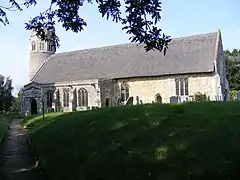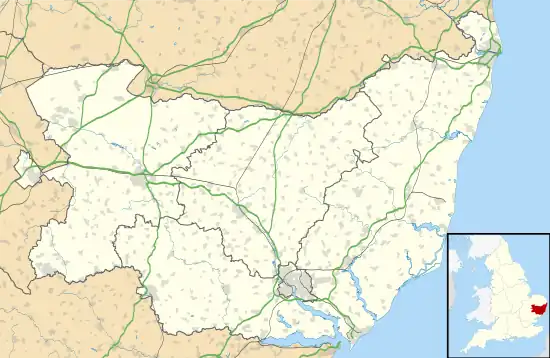| Theberton | |
|---|---|
 Church of St Peter, Theberton | |
 Theberton Location within Suffolk | |
| Population | 279 (2011)[1] |
| Civil parish |
|
| District | |
| Shire county | |
| Region | |
| Country | England |
| Sovereign state | United Kingdom |
| Post town | Leiston |
| Postcode district | IP16 |
| Police | Suffolk |
| Fire | Suffolk |
| Ambulance | East of England |
| UK Parliament | |
Theberton is a village in Suffolk, England. It is located 4 miles (6 km) north-east of Saxmundham, and 3 miles (5 km) miles north of Leiston, its post town.
History
During the First World War, a German Zeppelin airship, L48, was shot down near Theberton at 02:00 on the morning of 17 June 1917, by Robert Saundby and others, while it was on a bombing raid.[2][3][4] Sixteen members of the crew died in the crash; three survived but one later died from his injuries.[3] The bodies of the crew were buried in a dedicated plot adjacent to the churchyard, with women munition workers voluntarily digging the graves.[5] Local people tended the graves until 1966, when they were reinterred at Cannock Chase German Military Cemetery in Staffordshire. A memorial plaque remains across the road from the church, where part of the Zeppelin framework is mounted in the porch.[6]
The village primary school was closed around 1970 and is now used as the village hall. It was renamed Jubilee Hall in 2000 and extensively refurbished in 2012.
People
At Theberton Hall
William Light, founding father of Adelaide, South Australia, was sent from Penang in about 1792, aged six, to be educated by friends of his father, George and Anne Doughty, who lived at Theberton Hall.[7][8] George Doughty (d. 21 August 1798) was Sheriff of Suffolk,[9] and it was he who had had Theberton Hall built.[10] His wife, Anne Goodwin, was heiress of Martlesham Hall (died 12 May 1829). Their son was Rev. George Clarke Doughty, also of Theberton Hall.[11]
Charles Montagu Doughty (1843–1926) the traveller and writer, best known for his 1888 travel book Travels in Arabia Deserta, was born at Theberton Hall and is commemorated in the church by a plaque. Theberton Hall was also the birthplace of his nephew, Lt-Col. Charles Doughty-Wylie, who was born in 1868 and killed in battle in Gallipoli in 1915. His bravery earned him the Victoria Cross, awarded posthumously.[12]
Robert Howlett
The Victorian photographer Robert Howlett was born in Theberton in 1831, the second of four sons of the Rev. Robert Howlett and Harriet Harsant. He is renowned for his iconic photograph of Isambard Kingdom Brunel.
Heritage buildings
Theberton Hall
Theberton Hall was built for George Doughty (died 21 August 1798) in 1780[13][14] or 1792[10] (architect unknown). In 1852 there were extensive alterations and extensions in Italian Renaissance style, but nearly all of the additions were demolished in the 1920s. It is a two-storey building of yellow brick, stone and with stucco decoration. The central doorway has a porch with square pillars and Ionic columns. The parapet bears the motto "PALMA NON SINE PVLVERE", with the coat of arms above. It remained the home of Charles Montagu Doughty and on 25 October 1951 it was listed as a Grade II heritage-listed building.[10]
The motto comes from the Roman poet Horace, with the literal meaning "no palms without dust" (the palms referring to the prize awarded to the winners of chariot races). It is usually translated as "no reward without effort" and sometimes more recently as "dare to try".[15]
In 1928, Mrs Doughty-Wylie (presumably Lilian, the widow of Charles Doughty-Wylie, and the only woman on the Allied side to visit Gallipoli during the campaign, when she went to lay a wreath on his grave on 17 November 1915[12] offered "to commemorate the old friendship between the family of the late Colonel Doughty-Wylie and that of Colonel William Light", Theberton Hall and the estate to Adelaide City Council. The estate was described as "690 acres (280 ha) in extent, including 70 acres (28 ha) of matured woodlands", while the house had "six reception rooms and 18 bed and dressing rooms".[13] The Council referred the matter to High Commission of Australia, London for consideration. The investigators reported that the residence was said to be in poor repair, and would require immediate expenditure of £7,000 to £8,000, as well as ongoing expense, and so the Council declined the offer.[16]
Twinning
Theberton is twinned with Thebarton, a suburb of Adelaide in South Australia. Thebarton is named after the home of William Light, which he named Theberton House.[8]
Citations
- ↑ "Parish population 2011". Retrieved 17 September 2015.
- ↑ Above the Trenches: A Complete Record of the Fighter Aces and Units of the British Empire Air Forces 1915-1920. p. 330.
- 1 2 redkitebooks.co.uk, Aviation Archaeology, Zeppelin L48 excavation carried out for BBC television
- ↑ redkitebooks.co.uk, The excavation of L48 the “Theberton Zeppelin”, post-excavation report
- ↑ M. Mower, Zeppelin over Suffolk Barnsley 2008, p. 87 with photo ISBN 1844157377
- ↑ , Zeppelin, German zeppelin pictures, L48, LZ95, zeppelin crash.
- ↑ Elder, David F. "Light, William (1786–1839)". Australian Dictionary of Biography. National Centre of Biography, Australian National University. ISSN 1833-7538. Retrieved 19 October 2019.
This article was first published in hardcopy in Australian Dictionary of Biography, Volume 2, (MUP), 1967
- 1 2 "Place names of South Australia: T". State Library of South Australia. H.C. Talbot says: "When William Light was a boy, his father sent him to England from Penang to be educated to his trusted friend, George Doughty of Theberton Hall, in Suffolk... He built a home on section 1, Hundred of Adelaide which he called Theberton House". Retrieved 29 October 2019.
{{cite web}}: CS1 maint: others (link) - ↑ "The Colonel Light Statue". The Advertiser (Adelaide). Vol. XLIX, no. 15, 011. South Australia. 27 November 1906. p. 7. Retrieved 28 October 2019 – via National Library of Australia.
- 1 2 3 Historic England. "Details from listed building database (1287529)". National Heritage List for England. Retrieved 27 November 2019.
- ↑ Steuart, Archibald Francis (1901), A short sketch of the lives of Francis and William Light: the founders of Penang and Adelaide, with extracts from their journals, Sampson Low, Marston & Co., retrieved 29 October 2019 (Trove catalogue entry here)
- 1 2 "Charles Doughty-Wylie's Grave, Seddülbahir". Anzac Portal. Gallipoli and the Anzacs. Retrieved 28 November 2019.
- 1 2 "Colonel Light's Boyhood Home". The Adelaide Chronicle. Vol. LXX, no. 3, 738. South Australia. 12 May 1928. p. 18. Retrieved 28 November 2019 – via National Library of Australia.
- ↑ "Theberton Genealogical Records". Forebears. Retrieved 28 November 2019.
—Kelly's Directory of Suffolk (1900)
- ↑ "School Crest". Korowa Anglican Girls' School. Retrieved 28 November 2019.
- ↑ "Theberton Hall". The Register (Adelaide). Vol. XCIII, no. 27, 252. South Australia. 18 December 1928. p. 10. Retrieved 28 November 2019 – via National Library of Australia.
References
- Above the Trenches: a Complete Record of the Fighter Aces and Units of the British Empire Air Forces 1915-1920. Christopher F. Shores, Norman L. R. Franks, Russell Guest. Grub Street, 1990. ISBN 0-948817-19-4, ISBN 978-0-948817-19-9.
- Mower, Mark Zeppelin over Suffolk. The Final Raid of the L48 Barnsley Pen & Sword 2008 ISBN 1844157377
Further reading
External links
Council website: History » Theberton & Eastbridge
![]() Media related to Theberton at Wikimedia Commons
Media related to Theberton at Wikimedia Commons